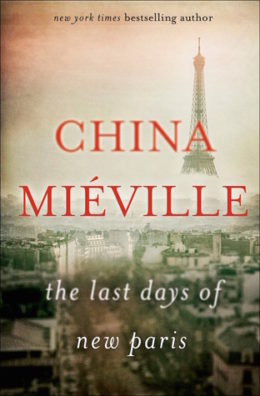China Miéville has been incredibly productive this past year.
His latest short novel, The Last Days of New Paris, is his third new release since August 2015’s fat story collection Three Moments of an Explosion and January’s mysterious sorta-Bas-Lag novella, This Census-Taker. (This in addition to his work with Salvage magazine and a children’s picture book forthcoming in the fall.) Of the three, The Last Days of New Paris is likely the most approachable and the easiest to follow along with, which is a bit rich as the action centers around Surrealist art coming to life and overtaking Nazi-occupied Paris in WWII.
And if that summary gets your interest, then so, too, will The Last Days of New Paris. Alternate history via Miéville’s exemplary imagination creates an ideal forum to consider fascism and art, or fascism versus art, as the case may be. A look back at this moment of never-was time feels particularly timely now.
The basic premise is that in 1941, American Jack Parsons — a real person, with “rocket scientist” and “occultist” and “mistress left him for L. Ron Hubbard” in his incredible Wikipedia entry — and a group of famous surrealists including André Breton, accidentally facilitate an “S-Blast” that populates districts of occupied Paris with shambling nightmare manifestations of Surrealist art, like Max Ernst’s Celebus elephant, or winged monkeys with owl’s eyes from a Dorothy Tanning painting. While these unlikely, uncanny creations trample over Nazi forces and resistance fighters alike, Hell teams up with Hitler, but sends its own demonic agents into the mix for some added chaos.
Thus the war extends into 1950, where Thibaut, the sole survivor of his resistance cell of artists, must help a young woman who may or may not be a journalist document these manifs and stop the Nazis’ next escalation in the magical arms race, a dangerous top secret operation named Fall Rot. Like characters from a D&D campaign, Thibaut and Sam have enchanted items to help them escape Vichy Paris; he a pair of woman’s pajamas from a poem and a manif-capturing camera for her. The duo needs to go back to the site of the S-Blast to stop the new Big Bad and, naturally, it’d be no fun if both Sam and Thibaut were exactly what they seemed.
Overall The Last Days of New Paris certainly fun. There’s a whimsy to the bestiary of wolf-tables and wailing baby heads. But one should definitely read the footnotes alongside the story. It did help ground the work in history, as Miéville reaches deep into the Surrealist movement to go beyond the more known works of Breton and Dalí — don’t worry, Lobster Telephone is included — to more obscure paintings and journals. But sometimes I wondered to what end did I need to know the origins of certain manifs? It didn’t make them any more (or less) interesting to the story. A notable exception would be the exquisite corpse that joins the proceedings in the latter half of the book. A little puff of steam from a train in a living art piece’s beard shouldn’t evoke such Iron Giant levels of pathos, but it does.

What did strike me was that, at first, I didn’t know what the term “manif” referred to, so of course I ran it through Google to translate and learned that manif is French for demonstration. Was that intentional? Perhaps, but either way, it did add an extra bit of sadness and meaning to the artists who contributed, however unintentionally, to the further destruction of their city. Protests run amok, yes, but not necessarily in a bad way. More in a way that destruction can lead to change, revolution.
As events move towards the big climax of Fall Rot, one gets a sense that there can only really be one true big boss to fight at the end of a book about Nazis. As in Railsea or Kraken or even Embassytown, the ending isn’t much of a shocker, but it feels satisfying and true in its inevitability. And, here, frightening in its implications. The very end of the book is an afterword from the author which reads more like a “classic” Miéville short work, where an old man claiming to be from new Paris, quite likely Thibaut himself, wants, needs, the author to record his memories of another time, another city. It’s a wonderful and tense little coda to a novel about lines blurred between imagination and reality.
While The Last Days of New Paris didn’t leave me scratching my head as This Census-Taker did, I ultimately don’t think that I’ll be pondering this for as long, either. Except for the next time I visit the Museum of Modern Art and view the Magrittes, the Bretons, the Man Rays, the Tanguays and wish for them to come alive. But my New York City has different dreams, I think. Dreams for a different artist to make, a different author to transcribe. But finding one as clear in his uncertainty as Miéville will likely prove extremely difficult.
The Last Days of New Paris is available now from Del Rey.
Read an excerpt here on Tor.com
Theresa DeLucci is a regular contributor to Tor.com, covering book reviews, gaming, and TV, including HBO’s Game of Thrones. She’s also discussed entertainment for Boing Boing, Den of Geek, and Wired.com’s Geek’s Guide to the Galaxy. She is a graduate of the 2008 Clarion West Writers’ workshop, and her short fiction has appeared in ChiZine. Follow her on Twitter.










